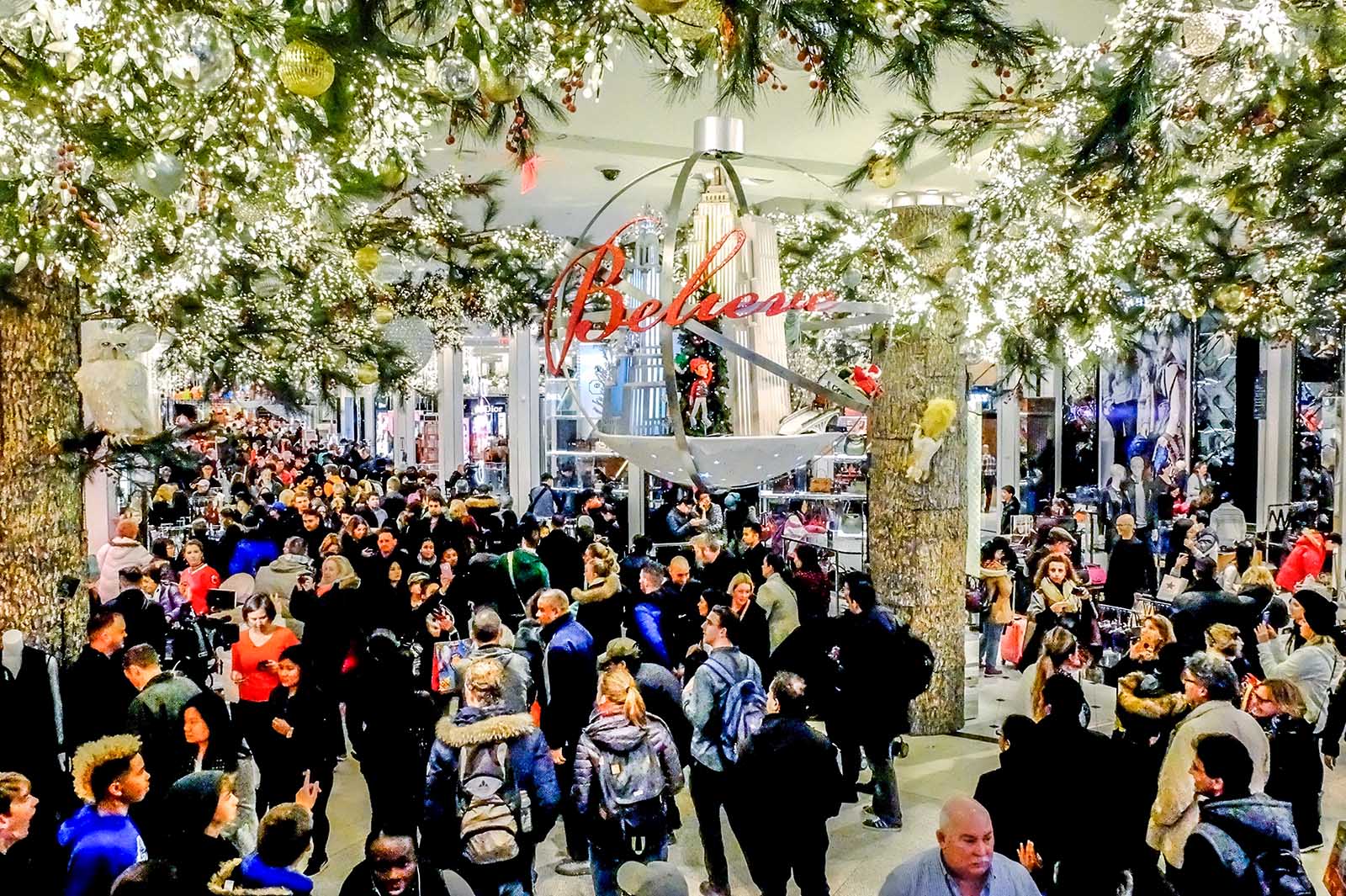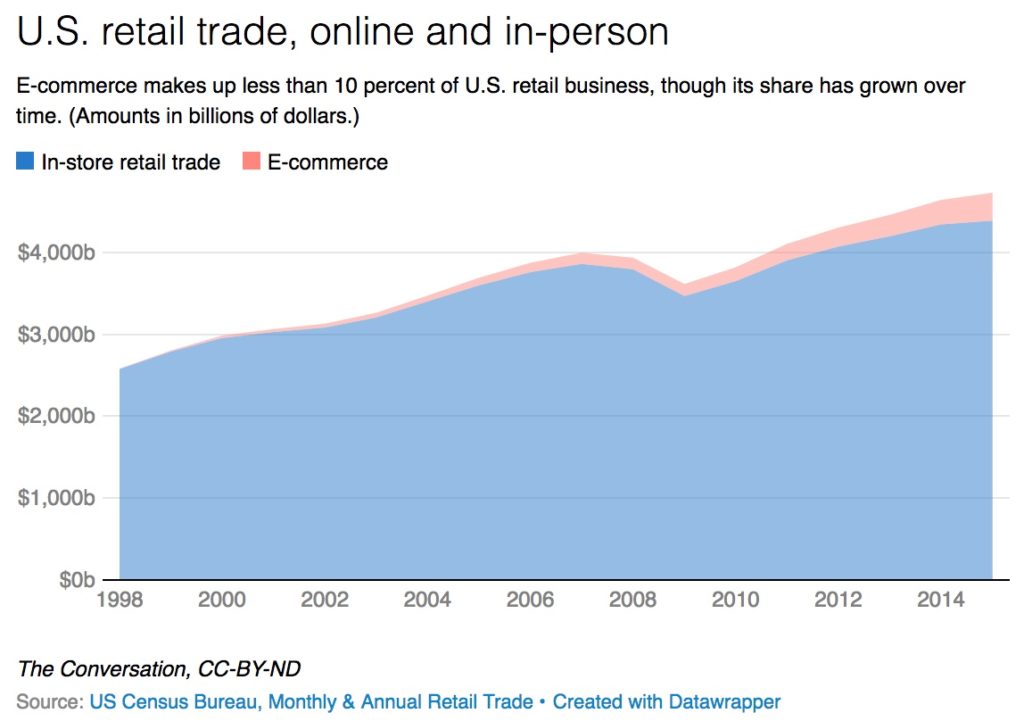In-Store Shopping Still Matters for Holiday Season

Shoppers walk inside a Macy's store during Black Friday events in New York City. The day after Thanksgiving, called Black Friday, is typically the biggest shopping day of the year in the United States.
Photo: Eduardo Munoz Alvarez/Getty Images
It surprises most millennials to learn that only about 10 percent of all retail purchases are actually made online. Each semester, when I ask hundreds of undergraduate business students to estimate, they consistently guess that between a quarter and half of all retail spending happens on the Internet. But this holiday shopping season, as ever in the past, the overwhelming majority of purchases will still happen within four physical walls of a store.
This should encourage the thousands of retailers anchored in strip malls, lifestyle centers and mixed use developments. The National Retail Federation expects holiday retail sales—not counting car, gas and restaurant purchases—in November and December this year to increase up to 4 percent over last year, to as much as $682 billion.
Stores will need the money to avoid being added to 2017’s record-breaking roster of retail bankruptcies, store closures and layoffs, which included landmark brands like Toys R Us and RadioShack.
A Reason to Visit
Traditional retailers must give consumers good reasons to visit their stores, beyond product selection and good value. Joe Pine and James Gilmore’s 1999 book “The Experience Economy” foretold how savvy companies, such as Apple and American Girl, excel by staging compelling experiences that teach, entertain or inspire customers.
The main asset of a physical store in a digital world is human staffing. Even if a shopper doesn’t want help, a smile acknowledging their presence encourages connection. Front-line employees can ask customers about their kids, in-laws or Thanksgiving meal planning. That can lead to an authentic personal connection through which employees can discover a shopper’s unique wants and respond with products on the shelves or ordered and shipped for free to the customer’s home. An in-person encounter can become a seamless blend of the online and physical worlds.
Even Walmart, America’s largest retailer, is moving to a more experiential model. In hopes of boosting sales, its 4,700 stores will host 20,000 parties with Santa before the new year. Customers will be able to take pictures, test out toys and get tots excited.
The company has another advantage over online sellers, too: nine in 10 Americans live within 15 minutes of a Walmart store. A thousand Walmarts now let customers drive up to the storefront to pick up online grocery orders the same day they’re purchased, at no additional charge. That rivals Amazon’s Fresh grocery service, which comes at an extra cost and often doesn’t deliver until the next day.
Emotional Connection in a Digital Age
Beyond face-to-face service, successful companies today must develop a deeper connection with their customers, whether online or off. Store-based retailers can show their values in ways that at times can take on a very personal meaning for shoppers and store owners alike. I have been a loyal customer of Gallery Furniture in Houston for years. Owner Jim McIngvale, known as “Mattress Mack,” is a marketing maverick known for his decades of zany TV commercials pledging to “save you money!”
After the devastation of Hurricane Harvey, he opened his stores to anyone in need of a place to stay. Some came by boat with only the clothes they were wearing. McIngvale welcomed thousands of Houstonians to sleep on his inventory of mattresses. On Halloween, McIngvale flew 50 first responders to Game 6 of the World Series in Los Angeles, giving those lucky Astros fans a once-in-a-lifetime experience and emotional lift in the wake of natural disaster.
Like other retailers gearing up for the holidays, Gallery Furniture is promoting “monster sales.” But with the floodwaters gone and the Astros crowned as baseball’s world champions, McIngvale’s community spirit seems to have positioned his chain as more than a brand, destination or store. Beyond capturing market share, Gallery Furniture may have an advantage in customer sentiment.
Best Buy is Buzzing Again
Community involvement isn’t the only way retailers can regain strength. National electronics chain Best Buy has ridden a roller coaster over the last 20 years: In 2004 it was recognized by Forbes magazine as “Company of the Year.” By 2012 it was dismissed as a real-world showroom for cheaper online retailers. In August 2017, though, its stock price hit an all-time high.
As Amazon grew, Best Buy defended itself, becoming a top 10 retailer in sales by matching competitors’ prices and investing in personal services like Geek Squad. The company also trained workers to help customers understand technology: Product descriptions can list a camera’s functions, but a knowledgeable employee can explain how it works with lenses, editing software or with other devices. That allows the company to take advantage of the ever-increasing number of tech-connected items in smart homes, from Nest thermostats to 4K TVs, which require more instruction to set up and operate than their analog predecessors.
In the face of online competition, brick-and-mortar retailers must give consumers unique in-store experiences that build emotional connections with shoppers. Black Friday promos on toasters or iPads won’t cut it. They have to provide heartfelt feelings such as surprise, delight and excitement—and provide actual help and useful advice. Shopping on a couch via a mobile app is efficient, but a store can be magical and memory-making.
This piece first appeared in The Conversation.





